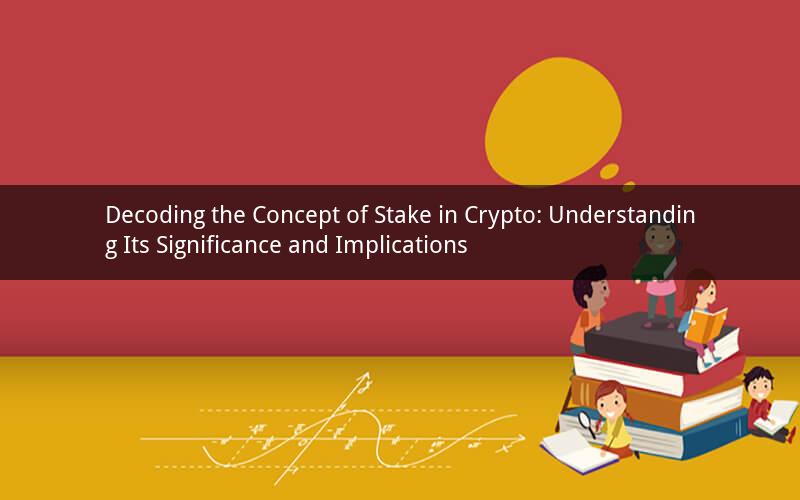
Introduction:
In the rapidly evolving world of cryptocurrencies, the term "stake" has gained significant importance. But what exactly does it mean? This article delves into the concept of stake in crypto, its implications, and its role in the crypto ecosystem.
Section 1: Understanding Stake in Crypto
1.1 Definition of Stake
Stake in crypto refers to the act of locking up a certain amount of cryptocurrency tokens to participate in a network's consensus mechanism. By staking, users contribute to the network's security and validation process, thereby earning rewards in the form of additional tokens.
1.2 The Significance of Staking
Staking plays a crucial role in the crypto ecosystem by ensuring the network's decentralization, security, and efficiency. It incentivizes users to hold and support the network, as they can earn rewards for their contribution.
Section 2: How Staking Works
2.1 Consensus Mechanisms
Staking is primarily associated with consensus mechanisms like Proof of Stake (PoS) and Delegated Proof of Stake (DPoS). In these mechanisms, validators are responsible for validating transactions and adding new blocks to the blockchain.
2.2 Locking Up Tokens
To participate in staking, users need to lock up a certain amount of tokens. The locked tokens act as collateral, ensuring that validators have a vested interest in maintaining the network's integrity.
2.3 Rewards and Penalties
Validators who successfully validate transactions are rewarded with additional tokens. However, if a validator behaves maliciously or fails to validate transactions, they may face penalties, including losing their staked tokens.
Section 3: Benefits of Staking
3.1 Rewards
One of the primary benefits of staking is the potential to earn additional tokens. Users can earn rewards based on the amount of tokens they have staked and the network's staking rate.
3.2 Network Security
Staking enhances network security by incentivizing users to hold and support the network. This decentralized approach reduces the risk of a single point of failure, making the network more resilient to attacks.
3.3 Decentralization
Staking promotes decentralization by allowing anyone with the necessary tokens to become a validator. This ensures that the network remains in the hands of its users, rather than being controlled by a centralized entity.
Section 4: Risks and Challenges of Staking
4.1 Market Volatility
One of the main risks of staking is the volatility of the crypto market. If the value of the staked tokens decreases significantly, users may face financial losses.
4.2 Lock-up Periods
Many staking platforms require users to lock up their tokens for a certain period. This can limit liquidity and may pose challenges for users who need to access their funds.
4.3 Regulatory Risks
Staking is subject to regulatory scrutiny in various jurisdictions. Users should be aware of the legal implications and comply with the applicable regulations.
Section 5: Popular Staking Platforms
5.1 Exchanges
Many popular cryptocurrency exchanges offer staking services, allowing users to earn rewards on their held tokens. Some notable examples include Binance, Coinbase, and Kraken.
5.2 Wallets
Some wallets also support staking, enabling users to earn rewards directly from their digital wallets. Examples include Ledger Nano S and Trezor Model T.
5.3 Independent Staking Platforms
Several independent staking platforms allow users to stake their tokens and earn rewards. These platforms often offer competitive interest rates and additional features, such as token swaps and liquidity pools.
Frequently Asked Questions:
1. What is the difference between Proof of Work (PoW) and Proof of Stake (PoS)?
Proof of Work (PoW) requires validators to solve complex mathematical puzzles to validate transactions and create new blocks. Proof of Stake (PoS) allows validators to be chosen based on the number of tokens they have staked.
2. Can I participate in staking if I don't own a significant amount of tokens?
Yes, many staking platforms allow users to participate in staking by pooling their tokens together. This allows even small token holders to earn rewards.
3. How do I choose the right staking platform?
When choosing a staking platform, consider factors such as the platform's reputation, security measures, interest rates, and customer support.
4. Can I unstake my tokens at any time?
The ability to unstake tokens depends on the staking platform and the specific cryptocurrency. Some platforms may require a lock-up period, while others allow users to unstake their tokens at any time.
5. Are there any risks associated with staking?
Yes, staking involves risks such as market volatility, lock-up periods, and regulatory changes. Users should conduct thorough research and consider their risk tolerance before participating in staking.